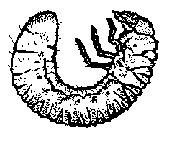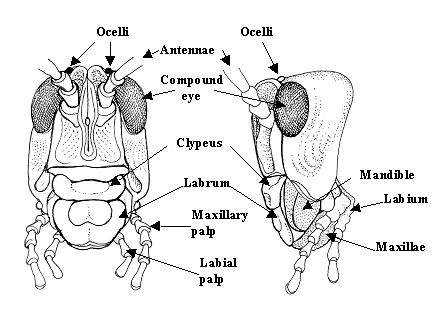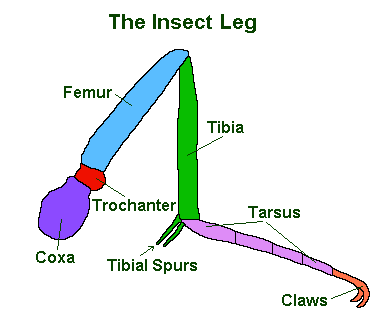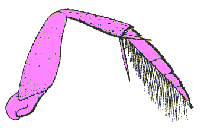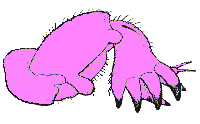Difference between revisions of "Entomology"
| Line 139: | Line 139: | ||
**Reproductive division of labor - sterile (or less fecund) individuals work for the benefit of a few reproductive individuals | **Reproductive division of labor - sterile (or less fecund) individuals work for the benefit of a few reproductive individuals | ||
**Overlap of generations - offspring contribute to colony labor while their parents are still alive | **Overlap of generations - offspring contribute to colony labor while their parents are still alive | ||
| + | ===Advantages and Disadvantages of Living in Groups=== | ||
| + | '''Advantages''': | ||
| + | *Can accomplish feats that are impossible for solo insects | ||
| + | *Construction of huge nest sites | ||
| + | *Widespread foraging for food | ||
| + | *Constant vigilance against predation or parasitism | ||
| + | '''Disadvantages''': | ||
| + | *Large colonies are especially vulnerable to the spread of contagious pathogens | ||
| + | *Nest sites may be exploited by "social parasites" who steal food or attack the brood | ||
| + | *Individuals must compete with each other for space and resources (such as food) | ||
=Insect External Anatomy= | =Insect External Anatomy= | ||
Revision as of 00:30, 19 June 2015
Entomology is an event in which competitors must be able to identify insects from 30 orders and 100 families. On most tests, questions about behavior, structure, human impact, and any characteristics of certain insects may be asked. This event is similar to the old Division B event, Don't Bug Me.
The 2015 Official Insect List is located on soinc.org.
What is an insect?
An insect is an invertebrate with several distinguishing characteristics. These characteristics, which are also outlined in the table below, include: segmented bodies with paired, many jointed legs; 3 major body sections; 6 legs; and 2 antennae.
Insect Taxonomy
All insects are classified as members of the following taxonomic groups:
- Kingdom: Animalia
- Phylum: Arthropoda
- Subphylum: Mandibulata
- Superclass: Hexapoda
- Class: Insecta
- Superclass: Hexapoda
- Subphylum: Mandibulata
- Phylum: Arthropoda
This table outlines major characteristics members of each group are required to possess.
| Level | Name of Rank | Characteristics Required |
|---|---|---|
| Kingdom | Animalia | Heterotrophic; Eukaryotic; Multicellular; No cell wall, no chloroplasts; Motile (able to move, opposite of sessile); Sense Organs. |
| Phylum | Arthropoda | Chitinous exoskeleton that must be shed during growth (molting); Jointed paired appendages (legs and antennae); Segmented bodies that are arranged into regions, called tagmata (e.g., head, thorax, abdomen); Bilateral symmetry; Ventral nervous system; Open, dorsal circulatory system; |
| Subphylum | Mandibulata | Have modified appendages (mandibles) flanking the mouth and used as jaws; |
| Superclass | Hexapoda | 3 pairs of legs (6 total) that are located on the thorax |
| Class | Insecta | Head, thorax, abdomen; 3 pairs of legs (one on each thoracic segment); One pair of antennae on head; 1-2 pairs of wings in most; Pair of compound eyes in most, along with 1-3 simple eyes; |
General Tips for ID'ing Insects
A very important part of this event is learning how to quickly identify the order and family of a given insect. The following is a list of tips for discerning the order/family of an insect.
- Color is generally not a good way to ID and differentiate insects.
- For orders such as Hymenoptera, Diptera, and Lepidoptera, wing venation is very important in ID'ing to the family
- Know each major order's defining traits.
- Diptera: Only one pair of functional wings, second pair of wings modified into halteres
- Hymenoptera: Forewings usually lager than hind wings, hooked together by hamuli
- Coleoptera: Forewings modified into elytra, which serve as protective covers for hind wings
- Lepidoptera: Two large pairs of wings; Hooked together by a frenulum
Insect Development
- Morphogenesis: All changes that involve growth, molting, and maturation
Molting
- Triggered by hormones released when an insect's growth reaches the physical limits of its exoskeleton
- Marks the end of one instar or growth stage, and the start of another
- When it becomes sexually mature, an inset is known as an imago or adult. At this point, molting stops and energy for growth is channeled into production of eggs or sperm.
- An insect cannot survive without the protection and support of its exoskeleton, so a new, larger one must be constructed inside the old one
Here is a summary of the processes involved in insect molting:
- Step 1: Apolysis -- separation of old exoskeleton from epidermis
- Step 2: Secretion of inactive molting fluid by epidermis
- Step 3: Production of cuticulin layer for new exoskeleton
- Step 4: Activation of molting fluid
- Step 5: Digestion and absorption of old endocuticle
- Step 6: Epidermis secretes new procuticle
- Step 7: Ecdysis -- shedding the old exo- and epicuticle
- Step 8: Expansion of new integument
- Step 9: Tanning -- sclerotization of new exocuticle
Types of Metamorphosis
Not all insects develop in the same way. Types of metamorphosis are grouped based on the number of stages required to reach sexual maturity. The table below explains the different types of metamorphosis and gives example groups.
| Metamorphosis Type (alternate name) | Description | Wing Type | Example Orders |
|---|---|---|---|
| Ametabola (no metamorphosis) | Young resembles the adult, but is smaller. Development involves increasing the insect's size by going through successive molts. | Apterogyte (adults like immature without wings) | Protura, Diplura, Thysanura, and Collembola |
| Hemimetabola (incomplete metamorphosis) | Developmental stages include egg, nymph, adult | Exopterygote (wings develop externally on the nymph body) | Emphemeroptera, Odonata, Blattodea, Mantodea, Isoptera, Grylloblattodea, Dermaptera, Plecoptera, Orthoptera, Phasmatodea, Psocoptera, Mallophaga, Anoplura, Thysanoptera, Hemiptera, Homoptera |
| Holometabola(complete metamorphosis) | Developmental stages include egg, larva, pupa, adult | Endopterygote (wings develop inside of body in immature insects and not visible until adult emerges from pupa) | Megaloptera, Neuroptera, Coleoptera, Strepsiptera, Mecoptera, Siphonaptera, Diptera, Trichoptera, Lepidoptera, Hymenoptera |
Larvae Appearance
Most larvae can be divided into five basic groups based on their appearance.
Pupa Appearance
Pupae can be grouped into one of three categories based on physical appearance.
Insect Behavior
Social Insects
Some groups of insects, such as termites and bees, live together in a common nest or colony. Social behavior can vary greatly from group to group. Different classifications of social behavior are outlined below.
| Classification Name | Common Nest Site | Cooperative Brood Care | Reproductive Castes | Generation Overlap |
|---|---|---|---|---|
| Solitary | No | No | No | No |
| Communal or Subsocial | Yes | No | No | No |
| Quasisocial | Yes | Yes | No | No |
| Semisocial | Yes | Yes | Yes | No |
| Eusocial | Yes | Yes | Yes | Yes |
Definitions for each classification outlined in the table are below:
- Solitary: Not sharing a nest or providing care for offspring
- Communal: Members of the same generation use the same composite nest site without cooperating in brood care
- Subsocial: Adults provide some kind of parental care for their offspring
- Quasisocial: Members of the same generation use the same composite nest site and also cooperate in brood care
- Semisocial: Cooperative brood care within a composite nest is provided by a worker caste that is more or less sterile
- Eusocial: Cooperative brood care within a composite nest is provided by a worker caste that is more or less sterile and lives long enough to assist the parents. In order to be considered eusocial, an insect group must possess all four of the following characteristics:
- Share a common nest site
- Individuals of the same species cooperate in caring for the young
- Reproductive division of labor - sterile (or less fecund) individuals work for the benefit of a few reproductive individuals
- Overlap of generations - offspring contribute to colony labor while their parents are still alive
Advantages and Disadvantages of Living in Groups
Advantages:
- Can accomplish feats that are impossible for solo insects
- Construction of huge nest sites
- Widespread foraging for food
- Constant vigilance against predation or parasitism
Disadvantages:
- Large colonies are especially vulnerable to the spread of contagious pathogens
- Nest sites may be exploited by "social parasites" who steal food or attack the brood
- Individuals must compete with each other for space and resources (such as food)
Insect External Anatomy
In this event, questions about general anatomy can come in two basic forms: diagrams to label, or arrows pointing to a specific structure on an insect. For the latter, competitors are generally asked to identify the structure, and possibly name its function.
Head
The head is the anterior oval-shaped body region that that houses the brain, a mouth opening, mouthparts used for ingestion of food, and major sense organs (including antennae, compound eyes, and ocelli). The surface of the head is divided into regions (sclerites) by a pattern of shallow grooves (sutures).
- Vertex: The uppermost sclerite (dorsal surface) of the head capsule
- Coronal Suture: runs along the midline of the vertex and splits into two frontal sutures as it extends downward across the front of the head capsule
- Frons: The triangular sclerite that lies between these frontal sutures
- Epistomal Suture: A deep groove that separates the base of the frons from the clypeus
- Clypeus: A rectangular sclerite on the lower front margin of the head capsule
- Genae: Lateral sclerites that lie behind the frontal sutures on each side of the head
See [1] for more information and an interactive diagram of the head that includes all features listed above.
Eyes
Insects generally have two types of eyes, simple and compound eyes. For more information about insect eyes, please visit this website
Simple Eyes (Ocelli)
Most insects have three simple eyes, also known as ocelli, located on the upper front part of the head. Several insects lack ocelli or only have two. The term ocellus (the singular form of ocelli) is derived from the Latin oculus (eye), and literally means "little eye".
There are two distinct types of ocelli: dorsal ocelli (or simply "ocelli"), and lateral ocelli (or stemmata).
Dorsal ocelli are commonly found in adults and in the immature stages (nymphs) of many hemimetabolous species. They are not independent visual organs and never occur in species that lack compound eyes. Whenever present, dorsal ocelli appear as two or three small, convex swellings on the dorsal or facial regions of the head. They differ from compound eyes in having only a single corneal lens covering an array of several dozen rhabdom-like sensory rods. These simple eyes do not form an image or perceive objects in the environment, but they are sensitive to a wide range of wavelengths, react to the polarization of light, and respond quickly to changes in light intensity. No exact function has been clearly established, but many physiologists believe they act as an "iris mechanism" -- adjusting the sensitivity of the compound eyes to different levels of light intensity. Dorsal ocelli are generally larger and more prominent in flying insects, such as bees, dragonflies, wasps, and locusts. In these insects, they are typically found in groups of three. Two lateral ocelli are directed to the left and right of the head, while a central ocellus is directed frontally. Some insects, such as ants and cockroaches, only possess two ocelli. In these cases, the median ocellus is absent, and both lateral ocelli are present.
Stemmata are the sole visual organs possessed by the larvae of insects that experience complete metamorphism, and certain adult orders that exhibit various types of metamorphism (ex: Collembola, Thysanura, Siphonaptera, and Strepsiptera). Stemmata always occur laterally on the head, and vary in number from one to six on each side. Structurally, they are similar to dorsal ocelli but often have a crystalline cone under the cornea and fewer sensory rods. Larvae use these simple eyes to sense light intensity, detect outlines of nearby objects, and even track the movements of predators or prey.
Compound Eyes
Compound eyes are the most commonly found visual organ of insects. They are situated on the upper portion of an insect's head. As suggested by their name, they are composed of many similar facets, called ommatidia. The number of ommatidia varies considerably from species to species: some worker ants have fewer than six while some dragonflies may have more than 25,000. For more information about the composition of an individual ommatidia, please see the link specified earlier in this section.
Antennae
The antennae are usually located on the front of the head below the simple eyes. They can be used to sense motion, orientation, odor, sound, humidity, chemicals in the air.
Antennae are divided into three basic parts: the scape: the basal segment that articulates with the head capsule; the pedicel: the second antennal segment; and the flagellum: all the remaining "segments" (individually called flagellomeres)
See [2] for pictures. The table found at this link is definitely something to include in a cheat sheet.
| Name | Examples |
|---|---|
| Setaceous: Bristle-like | Dragonflies |
| Filiform: Thread-like | Ground beetles and cockroaches |
| Moniliform: Bead-like | Termites |
| Serrate: Sawtoothed | Click Beetles |
| Clavate: Gradually clubbed | Carrion Beetles |
| Capitate: Abruptly clubbed | Butterflies |
| Pectinate: Comb-like | Fire-colored beetles and Male glow-worms |
| Plumose: Brush-like | Mosquitoes |
| Geniculate: Elbowed | Weevils and Ants |
| Aristate: pouch-like with lateral bristle | Houseflies |
| Flabellate/Flabeliform: Fan-like | Some beetles, Hymenoptera, Lepidoptera |
| Lamellate: Nested Plates | Scarab beetles |
| Stylate: Stylus-like | Robber flies; Bee flies |
Mouthparts
The mouth parts of an insect are located on the ventral or anterior part of the head. The mouth part structures typically present are the labrum (upper lip), jaw-like mandibles, jaw-like maxillae, a labium (lower lip), and the hypopharynx which acts as a tongue. Mouth parts are generally sucking or chewing. Insects with chewing mouth parts have lateral moving mandibles and chew their food, while insects with sucking mouth parts have parts like a beak which is called the proboscis through which liquid is sucked.
Thorax
This is the middle section of the body and is divided into 3 segments called the prothorax, mesothorax, and metathorax. Each segment bears a pair of legs, and the mesothorax and metathorax usually bear a pair of wings if the insect is not wingless. Each of the thoracic segments bear 4 groups of sclerites, or platelike areas. These are the notum (dorsally), pleuron (there's one on each side), and sternum (ventrally). These segments are then divided into even smaller segments.
Wings
The wings are located dorsolaterally (they're near the top) on the mesothroax and/or the metathorax. The muscles that move wings are attached to the walls of the thorax most of the time. Insect wings vary in number, size, shape, texture, venation, and in position held at rest making them a great assist in identification. Most insect wings are membranous, though some are thickened or leathery. Some are covered in hair and others in scales. Most insects fold their wings over the abdomen at rest, but others hold them vertically over the body or hold them outstretched. Here's a picture of wing venation:
General Venation
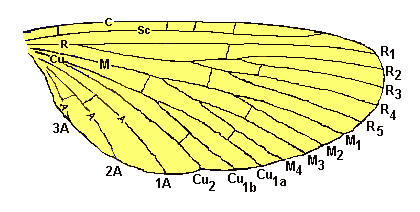 See bottom of http://www.cals.ncsu.edu/course/ent425/tutorial/wings.html for more.
See bottom of http://www.cals.ncsu.edu/course/ent425/tutorial/wings.html for more.
Legs
Most insects have three pairs of legs. Each leg contains five structural components (segments) that articulate with one another by means of hinge joints. These five components are known as the coxa, the trochanter, the femur, the tibia, and the tarsus.
Different insects' legs are modified for different tasks. This table outlines the major types of leg adaptations found in insects.
Abdomen
The abdomen typically consists of 11 segments, but the last segment is usually represented by appendages only. Many insects have fewer abdominal segments because of fusing of some insects. Each abdominal segment generally contains 2 sclerites (or hardened body wall plate), a dorsal tergum and ventral sternum. The terga usually extend down the sides of most segments and overlap the sterna. Most insects lack appendages on the abdomen other than at the posterior end. This appendages may be lacking or drawn into the body and hidden. When these terminal appendages are present, they usually consist of a pair of cerci, a median dorsal epiproct (appendage above anus), a pair of paraprocts (pair of lobes located below and on each side of anus), and genitalia. The anal opening is on the posterior end of the abdomen, right under the epiproct. The sexes in many groups can be identified by the genitalia at the end of the abdomen.
| Structure Name | Function | Description of Structure | Example Taxons |
|---|---|---|---|
| Pincers | Defense, courtship, folding wings | Heavily sclerotized and forceps-like | Dermaptera |
| Median Cadual Filament | A thread-like projection arising from the center of the last abdominal segment (between the cerci) | "Primitive" orders suchas Diplura, Thysanura, Ephemeroptera | |
| Cornicles | produce substances that repel predators or elicit care-giving behavior by symbiotic ants | paired secretory structures located dorsally on the abdomen of aphids | Aphididae |
| Abdominal Prolegs | Locomotion | Fleshy, found in larvae | Mostly Lepidoptera, also in Mecoptera and some Hymenoptera |
| Sting | Modified ovipositor | Found only in females of aculeate Hymenoptera (ants, bees, and predatory wasps) | |
| Abdominal Gills | Respiration | Ephemeroptera-paired gills are located along the sides of each abdominal segment; Odonata- the gills are attached to the end of the abdomen | Found in aquatic nymphs (naiads) of Ephemeroptera and Odonata |
| Furcula | "Jumping" | The "springtail" jumping organ found in Collembola on the ventral side of the fifth abdominal segment. A clasp (the tenaculum) on the third abdominal segment holds the springtail in its "cocked" position. | Collembola |
| Collophore | Maintains homeostasis by regulating absorption of water from the environment | Fleshy, peg-like structure found on ventral side of first abdominal segment | Collembola |
Insect Identification (Orders Only)
For more detailed information about each taxon (both orders and families), please visit the Entomology/Entomology Insect List page.
| Order Name (nickname) | Metamorphosis | Characteristics | |
|---|---|---|---|
| Protura (Telsontails) | Simple | conical head, piercing mouthparts, lacks eyes and wingless, 12 segments in abdomen, .6-1.5mm | |
| Collembola (Springtails) | Simple | wingless, long bodies, 4-6 abdominal segments, multicolored, tube protrudes from abdomen, microscopic | |
| Diplura (Diplurans) | Simple | 1-segmented tarsi, chewing mouthparts, 2 cerci on head | |
| Thysanura (Bristletails,Silverfish) | Simple | spindle shaped, flat bodies with 3 long, bristly tail like appendages | |
| Ephemeroptera (Mayflies) | Simple | distinguished easily by their two large, triangular wings | |
| Odanata (Dragonflies & damselflies) | Simple | two pairs of elongate membranous wings, compound eyes large, abdomen long and slender, antennae very short | |
| Plecoptera (Stoneflies) | Simple | 4 membranous wings, elongate, flattened, cerci present, long antennae, mouthparts chewing | |
| Orthoptera (Grasshoppers & crickets) | Simple | usually 2 pairs of wings, antennae many-segmented, cerci present, has ovipositor, FW is long, narrow, and many veined | |
| Blattodea (Roaches) | Simple | flattened oval bodies, long laid back antennae, wings (almost never used) | |
| Isoptera (Termites) | Simple | small, soft-bodies, usually pale-colored, antennae generally short and thread- or bead-like | |
| Dermaptera (Earwigs) | Simple | slender flattened bodies, large pincers at end | |
| Mallophaga (Chewing lice) | Simple | bristly body, toothed mandibles, small compound eyes, abdomen more wide or as wide as head | |
| Anoplura (Sucking lice) | Simple | flattened and wingless, sucking mouthparts, abdomen thiner than head | |
| Thysanoptera (Thrips) | Simple | slender bodies, short antennae, short legs, feathery wings | |
| Hemiptera (True bugs) | Simple | FW (front wing) thickened at base and membranous at tip, HW (hind) shorter than FW, wings held flat on body, tips of FW overlap, mouthparts sucking, antennae of 5 or fewer segments (long and conspicuous or short and concealed) | |
| Homoptera (cicadas and more) | Simple | beak short and rising at back of head (different from Hemiptera), wings held rooflike over body, tarsi 1- to 3-segmented, antennae sometimes short and bristlike or sometimes long and threadlike | |
| Neuroptera (dobsonflies, lacewings, antlions) | Complete (finally) | FW and HW almost same size, four membranous wings, wings held rooflike over body at rest, wings with many veins, antennae long, cerci absent, mouthparts chewing | |
| Coleoptera (beetles) | Complete | FW horny or leathery, FWs meet in straight line on back, HW membranous and are usually longer than FW, wings rarely absent or reduced, antennae usually with 11 segments (sometimes with 8-10), antennae variable in form | |
| Mecoptera (Scorpionflies) | Complete | slender, soft bodies; long legs and elongated, snout like heads | |
| Trichoptera (Caddisflies) | Complete | shaped or colored like certain moths, antennae long and threadlike, antennae usually long as body or longer, HW a little shorter than FW | |
| Lepidoptera (Moths & Butterflies) | Complete | 4 membranous wings, usually have proboscis in form of coiled tupe, wings covererd in scales | |
| Diptera (True flies) | Complete | one pair of membranous wings (you can identify them instantly from this), have knoblike projections called haltares | |
| Siphonaptera (Fleas) | Complete | laterally flattened abdomens, tough skin, enlarged coxae, mouthparts with 3 piercing stylets for blood sucking | |
| Hymonoptera (Bees, Ants, Wasps, and more) | Complete | wings are sometimes present, FW a little larger than HW, antennae usually fairly long |
Binder Checklist
*NOTE* The 2013-2014 competition only allows for one double-sided, 8.5 x 11 inches page of information. However, previous years have allowed for a binder, so it may still be helpful to create one for studying purposes.
Here is a binder checklist that was useful in the past: Make sure you have the following information in your binder or known by memory: Definitely necessary:
- Insect identification guide and sheets
- Nymph identification sheets
- Insect pictures (obviously)
- Insect characteristics sheets
- Human impact information
- Basic insect information
Optional:
- Entomology glossary (to be on the safe side)
- Note Sheets (for quick finding if they have a section where you must answer questions about insects not already identified) for the following:
- Vectors
- Record-winning insects (largest, smallest, fastest fliers, most deadly, etc.)
- Historical info. (safe side, horrible test making at state had at least five questions on this subject)
- Invasive species
Cheat Sheet Suggestions
In this event, there are a variety of ways in which one can structure their cheat sheet.
Method 1- Information and Pictures
This method involves having information about all of the families on one side of the sheet, and information about orders and other misc stuff on the other side. Information about all families and orders can be found on the Entomology/Entomology Insect List page. The identification tables at the end of each section are definitely a good idea for ID'ing, along with pictures.
| Aspect | Pro | Con |
|---|---|---|
| Location of Information During Test | Can be very easy to located information if you know the location of everything well | If you don't have a good idea of where everything is, it can be very hard to locate it in time |
| Amount of Information | Will include lots of information | Can sometimes be hard to fit everything, be careful about adding irrelevant information; |
| Identification | Because it includes both pics and descriptions, you will be much more confident in your identification of a specimen |
Resources
The following guides are highly recommended:
- Audubon Field Guide to Insects and Spiders: official field guide of the Entomology event, on which taxonomic scheme and questions are based on, has nice colored pictures and good bug descriptions, good for general insect knowledge; -note- this field guide groups bugs into groups based on their basic appearance rather than their correct phylogenetic groups (not good since the insects in here must be ID'd according to family and order), is also rather outdated regarding dates and population statistics, but contains the most reliable information simply because the test will be based on it.
- National Wildlife Federation Field Guide to Insects and Spiders & Related Species of North America: contains close-up color photographs with informative description, very up-to-date; -note- has more than 2,000 photos of over 940 species, which may be confusing. However, if you highlight only the necessary insects with the necessary families, the guide becomes much more clear.
- Peterson Field Guides: Insects - shows differences between different insects, has all insects on insect list; -note- contains a lot of information on how to collect and preserve an insect, which may not be useful when preparing for this event.
- Smithsonian Handbooks: Insects - really nice pictures, great for nymphs and larva identification; -note- thin and is best utilized as a supplement (the first two/three field guides are better suited for use during the event)
Good Links
- http://soinc.org/events/dontbugmeC/index.htm
- http://bugguide.net
- http://www.soinc.org/entomology_b
- mk3966's 2015 SSSS Notes
- http://www.cals.ncsu.edu/course/ent425/library/tutorials/index.html
Dichotomous Keys
On the tests, you may be asked to create a simple dichotomous key for identification of various insects. To create, just remember some simple tips:
There should be one less number of steps than number of insects you're including in the key.
You want to start off by dividing the insects into groups. If they do not have the insects already identified for you, then quickly identify them. For example, if they give you a house fly, a mantid, a dragonfly, and a mosquito, you'll divide them like this:
1. Two pairs of wings...................................go to 2
1. One pair of wings.....................................go to 3
Keep them very basic at first, then eventually divide them into more specific groups.
For example, you could then divide the two groups into colors, or whatever is most convenient.
Keep dividing the groups until you end up with the final step(since there are four insects in this case, there will be three steps) leading to the final insect being identified.
Human Impact
A very important aspect of this event is learning about how insects impact humans, the environment, and the world. Usually tests will feature stations with questions regarding identification and human/environmental/economic impact. Some insects are very prominent pests, such as certain species of Coleoptera, while others are highly beneficial, such as butterflies or bees that pollinate.
Beneficial Insects
Insect populations can have a positive impact on humans in a variety of different ways. They can be sources of food, decompose organic matter, manufacture products such as silk and honey, recycle carbon/nitrogen/other essential nutrients, and control populations of harmful invertebrates including other insects. Some are also valuable organisms to study for scientific and technological advances. Others have medical and therapeutic value.
Harmful Insects
In addition to having a positive effect on humans, insects can be very harmful. For example, some insects damage crops/trees and destroy products such as wood and paper. Many termites can destroy entire homes. Some can bite or sting, and many vector diseases. Others are household pests and parasites.
Disease Vectors
As stated above, many insects serve as vectors for diseases. Arbovirus is a term used to refer to a group of viruses that are transmitted by arthropod vectors. It is an acronym (ARthropod-BOrne virus). Haematophagous insects feed on blood at some stage of their life.
| Name of Insect | Disease |
|---|---|
| Siphonaptera (fleas) | Plague |
| Culicidae (mosquitoes) | Malaria, filarisis*, arboviral encephalitides, dengue fever, Rift Valley fever, West Nile encephalitis viral infection |
| Calliphoridae (blow flies) | Dysentery rabbit haemorrhagic disease, flystrike, salmonellosis |
*Only female mosquitoes of the genus Anopheles transmit malaria and filarisis
Recommendations For Group Members
Both team members should have a strong background in Environmental Science (AP Level). The team should be prepared for both types of events (visual: power point/pictures, and live specimens); a lack of practice in either area can result in false identifications. The team should be able to use various types of microscopes.




